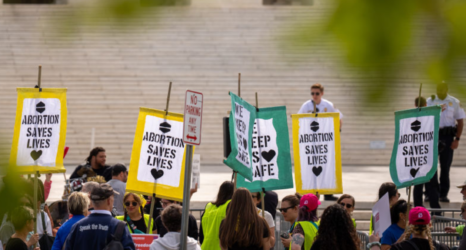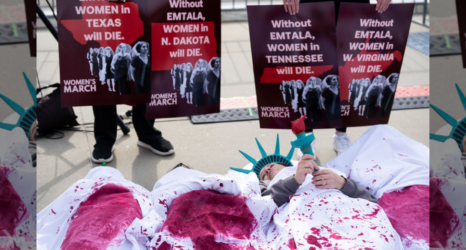What makes a portrayal of abortion on television revolutionary?
“Shrill,” a new comedy on Hulu that debuted earlier this month, has made headlines for its groundbreaking portrayal of fat women as complicated, real human beings—and for having a normal, common, even boring abortion plotline in the first episode. Annie, the main character the show based on Lindy West’s book of the same name, is a white, fat, millennial journalist on her journey towards self-actualization—which arguably starts with her abortion.
Despite common consensus, depicting abortion on television and film is nothing new. For the last five years, ANSIRH has tracked and analyzed abortion depictions on-screen—dating back to 1916’s Where Are My Children, a film inspired by Margaret Sanger’s trial and the first to depict an abortion provider; and the 1962 episode of “The Defenders“ that follows the trial of an illegal abortion provider and was the first television show to portray abortion.
Over the decades, we’ve found a steady increase in both television and film plotlines portraying abortion, whether they depicted an abortion provider, a person considering an abortion or someone actually having an abortion. But an increase in depictions does not guarantee representations that reflect the reality of abortion access in the U.S. We’ve found that fictional abortions are more dangerous than real life abortions; that characters who get an abortions are often younger, whiter and more affluent than real people who get abortions; and that characters can more often overcome barriers to abortion access that their real-life counterparts can’t.
When it comes to portraying the reality of abortion, “Shrill“ is a mixed bag. Most people who have abortions in the U.S. are people of color with children living at or below the federal poverty line; Annie is a young, childfree, white person who lives a decidedly middle-class life. We don’t see her worry about making ends meet, even when she quits her job in the final episode.
Annie is also able to get an abortion as soon as she wants one—which reflects her own reality in Oregon, where the show takes place, but doesn’t match up with women’s stories elsewhere in the U.S. Most states place multiple restrictions on abortion access, including withholding insurance coverage of abortion, limiting when in pregnancy a person can have an abortion and requiring that people wait one to three days before having an abortion.
When an audience sees how easy it is for a character to obtain an abortion, they might inadvertently assume that that’s the case for any person anywhere in the U.S. Even in Oregon, some people are forced to travel out of state and pay thousands of dollars out of pocket for their abortions. Annie doesn’t struggle to figure out how to afford her abortion, or investigate whether her insurance covers the procedure—a notable omission since insurance coverage of abortion is severely restricted.
Annie has a surgical abortion, depicted accurately as a simple outpatient procedure performed by a compassionate provider who talks her through every step of the process. We don’t know how far along Annie is in her pregnancy, but it’s curious that she does not consider having a medication abortion when about one-third of first trimester abortions are by pill.
These discrepancies are hardly unique to “Shrill,” and it’s unfair to expect one television show to depict every aspect of abortion as real people experience it. But it still matters that we talk about “Shrill” in the context of the myriad of other television shows that, taken together, help depict the reality of accessing abortion in the U.S. right now.
We’ve seen moms have abortions on “Crazy Ex-Girlfriend,” “Workin’ Moms” and “Big Mouth.” We’ve seen uneventful medication abortions on “Jane the Virgin,” “Brockmire” and “Please Like Me.”
Like “Shrill,” abortions on “Scandal” and “Glow” are transformational moments for Olivia and Ruth, respectively, to reflect on past mistakes and intentionally step into their own power. And other comedies like “Shameless,” “BoJack Horseman” and “You’re the Worst” used characters having abortions as opportunities to satirize abortion restrictions and anti-abortion protestors, depicting characters feeling empowered and unashamed.
We don’t have data about the body types of people accessing abortion on TV—and given the relative lack of fat characters at-large, it’s likely that Annie is one of the few who has had an abortion. But just last year, Gabby Siddibe’s character on Empire had an abortion with the support of a friend and ex-partner, but this depiction received very little coverage from media. That year, we also saw Black women talk about their abortions on “Empire,” “Claws,” “Insecure” and “Dear White People”—all with the support of friends or loved ones, too.
The mark of a revolutionary abortion episode may not be that it tells the most statistically accurate story of abortion, but that it treats the person having an abortion with compassion, love and respect. This should be the baseline of televised abortion depictions: allowing people who have abortions their full humanity, including feeling “really fucking powerful”—as Annie does after her abortion—and zooming out to put that abortion in the context of the broader reality of abortion access.
In a world where even the Writer’s Guild of America is speaking out against abortion restrictions, writers and showrunners must consider the impact of that depiction—what it says about the person having the abortion, and what it conveys about the climate of abortion access across the country. By giving us the full picture, they’ll make space for even more revolution in their representations of abortion.





